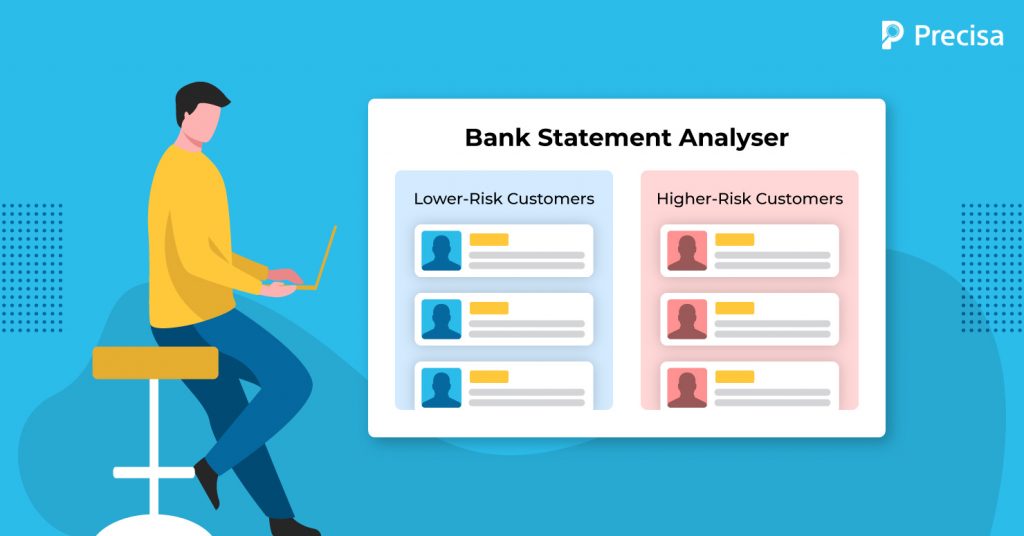How Bank Statement Analysers Are Aiding in the Search for Lower-Risk Customers

Global loan defaults have increased at a faster rate than they were before the pandemic. Direct consumers and small businesses are still struggling to pay back loans, which is unlikely to improve very soon.
While retail lending accounts for 22% of total bank lending and 3.7% of total NPAs, personal loans, home loans, and vehicle loans have lower delinquencies. Financial lending institutions must continue to offer loans; however, they cannot subject customers to undue hardships. Hence, they need proper methods to determine the applicant’s creditworthiness and decrease the risk of NPAs.
Bank Statement Analysers: How Can They Help Banks?
A detailed bank statement analysis is an effective technique to analyse the applicant’s financial history accurately. This can prevent NPAs and poor credit decisions. However, manually combing through pages of bank statement data is tiresome and inaccurate, especially when evaluating the financial health of multiple applicants.
This is where a bank statement analyser helps with accurate risk assessment of customers while reducing manual work. A smart system can tag and aggregate information in a visually appealing dashboard in minutes, regardless of the format or number of pages of the bank statement.
Transforming the Lending Experience with Bank Statement Analyser
With the introduction of new technologies, the banking industry has undergone significant changes. Lenders can now review credit applications faster, save costs, and improve the number of loans issued per month without sacrificing accuracy. This is because of the AI-ML-powered bank statement analyser.
Here are ways how a bank statement analyser can aid in searching for lower-risk customers, thus making the lending process efficient, reliable, and convenient
1. Assess Creditworthiness of Customers
Lending money to someone is a risky business, and banks must evaluate the customer before approving the loan. The easiest approach to determine the customer’s creditworthiness is to examine their bank statements.
An automated bank statement analyser examines the transactional data from the customer’s bank account, including essential debit and credit transactions. This provides a 360-degree view of the applicant’s income, average balance, obligations, transaction patterns, and spending habits, allowing for a thorough examination of their creditworthiness.
2. Lower Default Rate
The applicants’ intention to repay the loan is important to consider while evaluating their financial behaviour. The automated computational engine of the bank statement analyser assists lenders in determining red flag events in bank statements such as defaults/ non-payment, bounced cheques, and insufficient funds. This enables banks to find out any volatility that could affect the applicant’s ability to repay the loan.
It also aids in detecting frauds, such as loan fraud, payment fraud, and identifying forged or fraudulent documents. Furthermore, certain bank statement analysers often provide predictive analysis scores that give lenders a peek into the probability of loan defaults.
3. Higher Credit Underwriting Accuracy
Traditional processes for authorising loans and issuing credit to customers are time-consuming and error-prone. Pages after pages of spreadsheets and PDF files are not only difficult to organise but also increase the chances of errors.
Automated underwriting methods based on AI and ML can provide better confidence in credit determinations and higher acceptance rates than ever before.
4. Real-Time Analysis
The bank statement analyser can retrieve bank transaction data directly from the bank and interface with the existing systems via APIs. In addition, it allows you to upload bank statements in a number of different formats.
The engine then creates a complete real-time report for the transaction data that has been uploaded or downloaded. As a result, it can help with large-scale and swift credit assessments and real-time decision-making by providing valuable insights.
The majority of modern computers have an accurate OCR (optical character recognition) system that can transform various formats of bank statements into editable and searchable data. Hence, this reduces the amount of paperwork required and automates data extraction to limit the number of errors when manually assessing or extracting data from pages and pages of past bank statements.
This allows to delve further into the individual’s or company’s entire financial scorecard, as well as retrieve past data that may be important to the assessment.
A credit analytics tool like Precisa uses bank statement data to present a complete picture of the loan application. In addition, it assists in identifying data patterns and current trends to enable decision-making.
You can get a new perspective on your applicants and increase portfolio allocation performance, thanks to its streamlined system that is fully linked with the loan origination system (LOS).
5. Bottom Line
A bank statement analyser provides a detailed picture of a borrower’s financial situation. It aids in the generation of a report which determines a prospective borrower’s creditworthiness and loan repayment ability. Moreover, bank statement analysers can handle large amounts of transaction data, improving overall bank efficiency.
Precisa is an online bank statement analysis tool used by banks to process and analyse bank statements of potential loan applicants.
Precisa generates comprehensive, insightful, actionable reports in real-time that help banks better understand the borrower’s financial health, lowering the risk of NPAs or credit default. It’s also considerably cost-effective because it does not necessitate large teams working around the clock to make speedy decisions.
To know more, book a demo with Precisa today!




